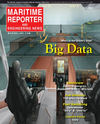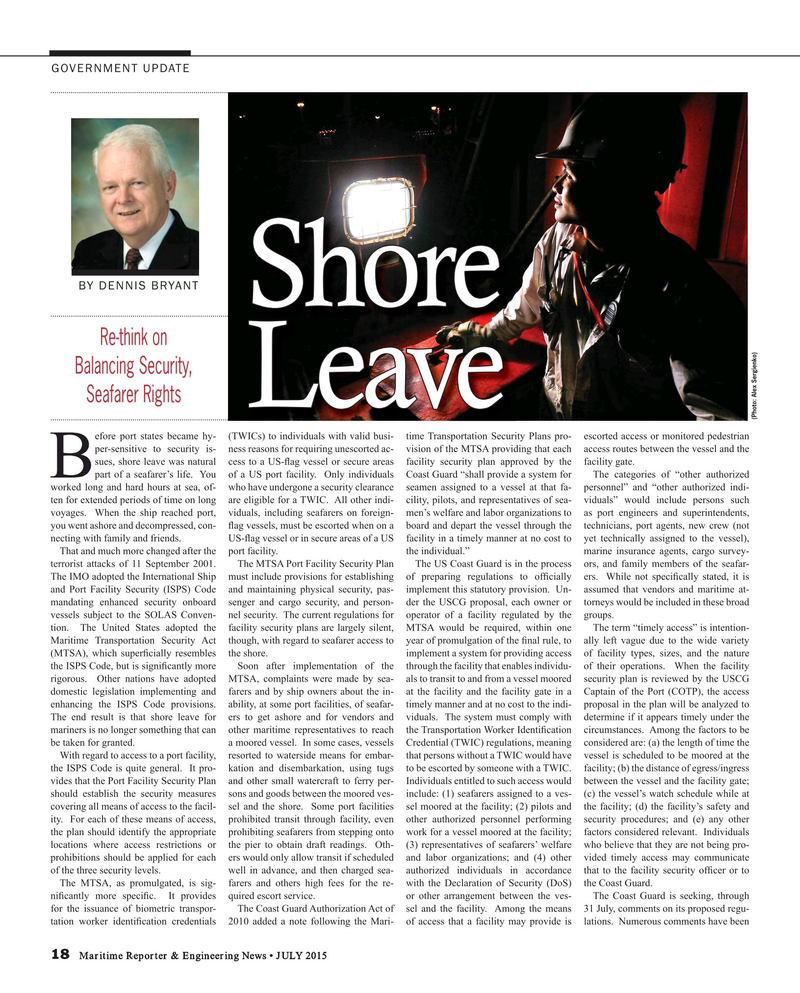
Page 18: of Maritime Reporter Magazine (July 2015)
Marine Communications Edition
Read this page in Pdf, Flash or Html5 edition of July 2015 Maritime Reporter Magazine
GOVERNMENT UPDATE
BY DENNIS BRYANT
Shore Shore
Re-think on
Balancing Security,
Seafarer Rights
LeaveLeave (Photo: Alex Sergienko) efore port states became hy- (TWICs) to individuals with valid busi- time Transportation Security Plans pro- escorted access or monitored pedestrian per-sensitive to security is- ness reasons for requiring unescorted ac- vision of the MTSA providing that each access routes between the vessel and the sues, shore leave was natural cess to a US-? ag vessel or secure areas facility security plan approved by the facility gate.
Bpart of a seafarer’s life. You of a US port facility. Only individuals Coast Guard “shall provide a system for The categories of “other authorized worked long and hard hours at sea, of- who have undergone a security clearance seamen assigned to a vessel at that fa- personnel” and “other authorized indi- ten for extended periods of time on long are eligible for a TWIC. All other indi- cility, pilots, and representatives of sea- viduals” would include persons such voyages. When the ship reached port, viduals, including seafarers on foreign- men’s welfare and labor organizations to as port engineers and superintendents, you went ashore and decompressed, con- ? ag vessels, must be escorted when on a board and depart the vessel through the technicians, port agents, new crew (not necting with family and friends. US-? ag vessel or in secure areas of a US facility in a timely manner at no cost to yet technically assigned to the vessel),
That and much more changed after the port facility. the individual.” marine insurance agents, cargo survey- terrorist attacks of 11 September 2001. The MTSA Port Facility Security Plan The US Coast Guard is in the process ors, and family members of the seafar-
The IMO adopted the International Ship must include provisions for establishing of preparing regulations to of? cially ers. While not speci? cally stated, it is and Port Facility Security (ISPS) Code and maintaining physical security, pas- implement this statutory provision. Un- assumed that vendors and maritime at- mandating enhanced security onboard senger and cargo security, and person- der the USCG proposal, each owner or torneys would be included in these broad vessels subject to the SOLAS Conven- nel security. The current regulations for operator of a facility regulated by the groups. tion. The United States adopted the facility security plans are largely silent, MTSA would be required, within one The term “timely access” is intention-
Maritime Transportation Security Act though, with regard to seafarer access to year of promulgation of the ? nal rule, to ally left vague due to the wide variety (MTSA), which super? cially resembles the shore. implement a system for providing access of facility types, sizes, and the nature the ISPS Code, but is signi? cantly more Soon after implementation of the through the facility that enables individu- of their operations. When the facility rigorous. Other nations have adopted MTSA, complaints were made by sea- als to transit to and from a vessel moored security plan is reviewed by the USCG domestic legislation implementing and farers and by ship owners about the in- at the facility and the facility gate in a Captain of the Port (COTP), the access enhancing the ISPS Code provisions. ability, at some port facilities, of seafar- timely manner and at no cost to the indi- proposal in the plan will be analyzed to
The end result is that shore leave for ers to get ashore and for vendors and viduals. The system must comply with determine if it appears timely under the mariners is no longer something that can other maritime representatives to reach the Transportation Worker Identi? cation circumstances. Among the factors to be be taken for granted. a moored vessel. In some cases, vessels Credential (TWIC) regulations, meaning considered are: (a) the length of time the
With regard to access to a port facility, resorted to waterside means for embar- that persons without a TWIC would have vessel is scheduled to be moored at the the ISPS Code is quite general. It pro- kation and disembarkation, using tugs to be escorted by someone with a TWIC. facility; (b) the distance of egress/ingress vides that the Port Facility Security Plan and other small watercraft to ferry per- Individuals entitled to such access would between the vessel and the facility gate; should establish the security measures sons and goods between the moored ves- include: (1) seafarers assigned to a ves- (c) the vessel’s watch schedule while at covering all means of access to the facil- sel and the shore. Some port facilities sel moored at the facility; (2) pilots and the facility; (d) the facility’s safety and ity. For each of these means of access, prohibited transit through facility, even other authorized personnel performing security procedures; and (e) any other the plan should identify the appropriate prohibiting seafarers from stepping onto work for a vessel moored at the facility; factors considered relevant. Individuals locations where access restrictions or the pier to obtain draft readings. Oth- (3) representatives of seafarers’ welfare who believe that they are not being pro- prohibitions should be applied for each ers would only allow transit if scheduled and labor organizations; and (4) other vided timely access may communicate of the three security levels. well in advance, and then charged sea- authorized individuals in accordance that to the facility security of? cer or to
The MTSA, as promulgated, is sig- farers and others high fees for the re- with the Declaration of Security (DoS) the Coast Guard.
ni? cantly more speci? c. It provides quired escort service. or other arrangement between the ves- The Coast Guard is seeking, through for the issuance of biometric transpor- The Coast Guard Authorization Act of sel and the facility. Among the means 31 July, comments on its proposed regu- tation worker identi? cation credentials 2010 added a note following the Mari- of access that a facility may provide is lations. Numerous comments have been 18 Maritime Reporter & Engineering News • JULY 2015
MR #7 (18-25).indd 18 MR #7 (18-25).indd 18 7/6/2015 10:01:11 AM7/6/2015 10:01:11 AM

 17
17

 19
19
